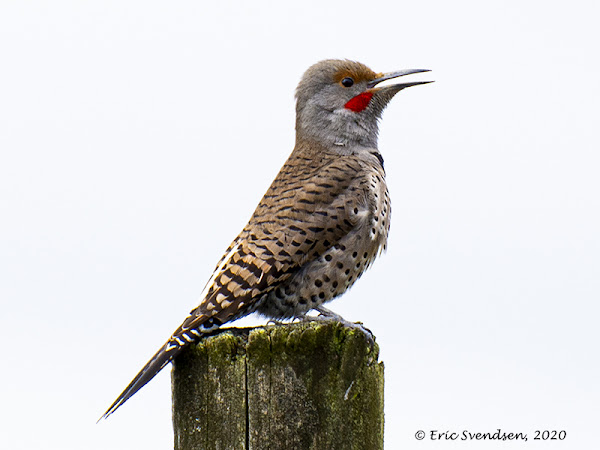Male flicker spotted.
Flickers are one of my favourite birds. They are amazing in just so many ways. First off, they are a type of woodpecker. Not that woodpeckers are uncommon, but there are many places in the world where such birds do not exist. Woodpeckers use their beaks to broach bark and excavate cavities, all in the name of gathering food. The skull is designed to withstand the pervasive pounding by a singularly unique method - their tongue is enclosed in a sheath that wraps around the brain to protect it. The tongue generally about four inches long making up about a third of the bird's length. The barbed tip juts through air and into crevasses to remove invertebrate morsels.
Another reason why I like flickers so much is because of their ground-dwelling habit. It turns out that they eat a lot of ants, larvae, pupae, and adults. They do this by finding an ant's nest site and raiding it. What is especially amazing is that they seem to have the ability to smell out the location of maturing pupae. A flicker will land on the ground and move around until it suddenly will plunge its hardened beak into the ground. It produces an ant pupa which it quickly ingests and then plunges again with the same result. Between their drilling expertise and tongue thrusts, the ants do not stand a chance. I have seen this with my own eyes. They will also alight on a tree and pick off ants that are on the trunk or in the canopy. Ants often tend colonies of aphids on trees and collect honeydew from their "herds" to be retrieved back to the nest in the ground. Flickers take advantage of their movement and benefit from those ants which have collected honeydew and are returning home.
Flickers are very common throughout most of North America. They used to be divided into two groups, the red-shafted flicker and the yellow-shafted flicker. The shaft refers to the colour of the main support column within each feather. I love finding flicker feathers; I am always enthralled by the colours and often sport one in my Australian hat's headband. Flickers migrate south during the winter as the cold usually means few ant meals and the snow will prevent them from foraging on the ground. Ants typically place their pupae near the surface during the summer so the sun accelerates maturation. Wintertime usually finds them hidden deep underground where the frost won't kill them.
Lastly, I love the spotted breast and barred back pattern which they have. If you watch one flying you will notice an undulating pattern; look at the rear end of the bird and you will see a white rump. They are robin-sized; the flight and feather patterns are harbingers of spring. During the cold winters, I always look forward to the familiar call in spring that announces that the flickers have returned.
Thanks for reading. Ericspix Eric Svendsen
Another reason why I like flickers so much is because of their ground-dwelling habit. It turns out that they eat a lot of ants, larvae, pupae, and adults. They do this by finding an ant's nest site and raiding it. What is especially amazing is that they seem to have the ability to smell out the location of maturing pupae. A flicker will land on the ground and move around until it suddenly will plunge its hardened beak into the ground. It produces an ant pupa which it quickly ingests and then plunges again with the same result. Between their drilling expertise and tongue thrusts, the ants do not stand a chance. I have seen this with my own eyes. They will also alight on a tree and pick off ants that are on the trunk or in the canopy. Ants often tend colonies of aphids on trees and collect honeydew from their "herds" to be retrieved back to the nest in the ground. Flickers take advantage of their movement and benefit from those ants which have collected honeydew and are returning home.
Flickers are very common throughout most of North America. They used to be divided into two groups, the red-shafted flicker and the yellow-shafted flicker. The shaft refers to the colour of the main support column within each feather. I love finding flicker feathers; I am always enthralled by the colours and often sport one in my Australian hat's headband. Flickers migrate south during the winter as the cold usually means few ant meals and the snow will prevent them from foraging on the ground. Ants typically place their pupae near the surface during the summer so the sun accelerates maturation. Wintertime usually finds them hidden deep underground where the frost won't kill them.
Lastly, I love the spotted breast and barred back pattern which they have. If you watch one flying you will notice an undulating pattern; look at the rear end of the bird and you will see a white rump. They are robin-sized; the flight and feather patterns are harbingers of spring. During the cold winters, I always look forward to the familiar call in spring that announces that the flickers have returned.
Thanks for reading. Ericspix Eric Svendsen




Comments
Post a Comment